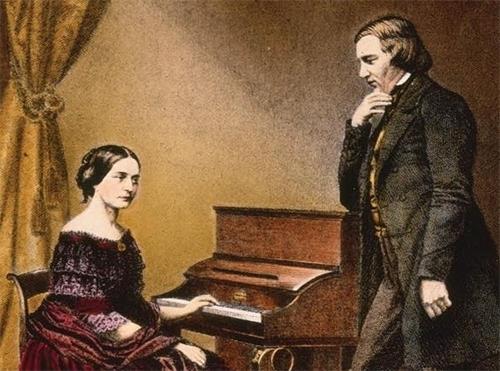
In 19th-century Europe, the love story of Robert Schumann and Clara Wieck was like a moving symphony, continuing to inspire future generations. Not only were they soulmates, but together, they composed a romance filled with passion and brilliance in the realm of music.
Schumann’s journey began with a conflicted choice. Instead of immersing himself in legal studies, he spent most of his time at the piano, lost in the poetry of Goethe and Byron.
It was during this pursuit of his passion that his story with Clara began. Clara, the daughter of Schumann’s piano teacher, Friedrich Wieck, first entered his life one spring afternoon in 1830. At just 11 years old, she had golden hair cascading like a waterfall and moved with an effortless grace—like a tiny star illuminating Schumann’s world. A piano prodigy, she was already making a name for herself, while Schumann was a young dreamer chasing his musical aspirations. In the Wieck household, they often played four-hand duets, sharing in the joy of music. As time passed, their bond grew beyond friendship into something deeper. By then, Clara had already become a celebrated pianist.
However, their love was far from smooth sailing. In 1835, when Clara returned home at 16, she and Schumann rekindled their affections. Yet, her father vehemently opposed their relationship, believing that Schumann’s social standing and financial situation were unworthy of his daughter. Determined to separate them, he took Clara away from Leipzig, forbade their correspondence, and even prohibited her from performing Schumann’s compositions. But despite the distance and obstacles, their love remained steadfast. They continued to exchange letters, pouring their hearts into each word, reaffirming their devotion to each other.
More than just a collection of piano pieces, it was a love letter in musical form. Each piece captured cherished memories of Clara’s childhood, blending emotion and imagination into a heartfelt tribute. Among them, Träumerei (Dreaming) stood out—a tender, dreamlike melody that embodied Schumann’s deep longing for Clara.
After four years of waiting and struggle, their love finally triumphed. In 1840, they were married. The following year, he composed his Spring Symphony, a work that reflected his joy and hopes for their life together. Each movement brimmed with youthful energy, its melodies evoking the vitality of spring. Moved by the music, Clara remarked, “I am completely overwhelmed with happiness.”
Their love not only inspired some of the most touching musical compositions of the era but also became one of the most legendary romances in 19th-century music. Following their marriage, Schumann’s creative output flourished, expanding beyond piano music to symphonies, lieder, and more. The triumphant premiere of his Spring Symphony marked a new artistic peak. Through it all, Clara remained his closest companion—supporting, encouraging, and inspiring him.
Their love was an endless melody, woven with sweetness, sorrow, longing, and hope. Even today, their entwined story of music and love continues to resonate, touching countless hearts.

Mara,Roy
From Expectation to Letting Go: An Irrevocable Tragic Love
Amid the turbulent changes of the 20th century, there was a poignant love story—like a radiant pearl, yet as fleeting and painful as a meteor over the sea.

Atlantis
Atlantis—A Mythical Tale or a Real Lost Civilization?
Atlantis, one of the most famous lost civilizations in the world, continues to hold an important place in the research of historians, archaeologists, and mythologists.

Tristan,Isolde
An Uncontrollable Fire of Love: The Tragic Passion of Tristan and Isolde
The love story of Tristan and Isolde shines like a brilliant gem in the river of history, radiating both tragedy and passion.


